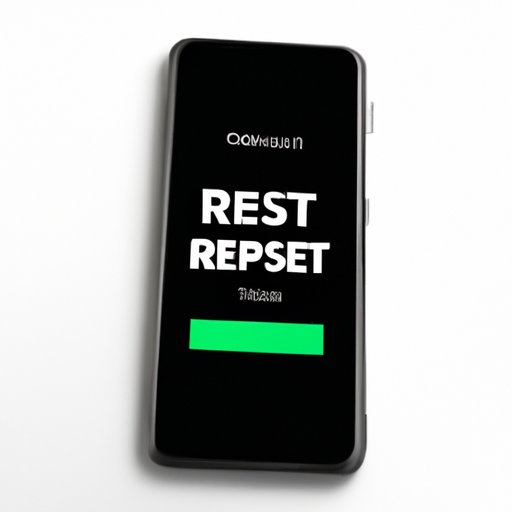Introduction
It can be frustrating when the screen on your iPhone stops working. You may think that all your data is lost, but there are ways to fix the issue. Knowing how to reset your iPhone if the screen doesn’t work is essential. In this article, we will discuss six ways to reset your iPhone in case the screen becomes unresponsive, and the importance of regularly backing up your data.
Method One: Restart Your iPhone Using Buttons
Restarting your iPhone is the simplest method to fix an unresponsive screen. It works with most iPhone models.
Here’s how to restart your iPhone:
- Press and hold the Sleep/Wake button (located on the right side of your iPhone).
- Drag the “slide to power off” slider to turn off the device.
- Wait for one minute before holding the Sleep/Wake button again.
- Release the button when the Apple logo appears.
Advantages of this method are that it’s easy to do and doesn’t require any additional tools. The disadvantage is that it won’t work if the iPhone is completely frozen.
To prevent the problem from happening again, you can try updating your iPhone’s software regularly (Settings > General > Software Update) and avoid overcharging your iPhone.
Method Two: Force Restart Your iPhone
If your iPhone is completely unresponsive even after restarting, you can try force restarting it. This method is useful in cases when the iPhone’s system has crashed.
Here are the steps for force restarting your iPhone:
- Press and quickly release the volume up button (located on the left side of your iPhone).
- Press and quickly release the volume down button.
- Press and hold the Sleep/Wake button until the Apple logo appears.
The advantage of this method is that it forces the iPhone to restart even when the screen is frozen. The disadvantage is that it may cause data loss if the iPhone’s system has crashed.
To prevent the problem from happening again, you can avoid using your iPhone while charging and not download apps from unverified sources.
Method Three: Restore Your iPhone Through iTunes
If force restarting doesn’t work, you can try restoring your iPhone through iTunes. This method erases all data and settings on your iPhone, so make sure to back up your data before doing this.
Here’s how to restore your iPhone through iTunes:
- Connect your iPhone to a computer with iTunes installed.
- Open iTunes and select your iPhone when it appears.
- Select “Summary” from the sidebar and click “Restore iPhone”.
- Follow the prompts to complete the restore process.
The advantage of this method is that it reinstalls the iPhone’s software, which can fix system bugs. The disadvantage is that it erases all data and settings on the device.
To prevent the problem from happening again, you can avoid downloading sketchy apps and regularly update your iPhone’s software.
Method Four: Enter Recovery Mode to Reset Your iPhone
If restoring your iPhone through iTunes is not an option, you can try entering recovery mode to reset your iPhone. This method reinstalls the latest iOS software without erasing any data.
Here’s how to enter recovery mode to reset your iPhone:
- Connect your iPhone to a computer with iTunes installed.
- Open iTunes and force restart your iPhone (as described in Method Two).
- Release the Sleep/Wake button when the iTunes logo appears on the screen.
- Click “Restore” when prompted on your computer.
The advantage of this method is that it can fix issues without erasing any data. The disadvantage is that it’s not always successful and may cause data loss if not done correctly.
To prevent the problem from happening again, you can use official iPhone charging cables and avoid overcharging your iPhone.
Method Five: Use a Third-Party iPhone System Recovery Tool
If none of the methods above work, you can use a third-party iPhone system recovery tool. These tools can fix various iOS issues, including an unresponsive screen.
Here’s how to use a third-party iPhone system recovery tool:
- Download and install the software on a computer.
- Connect your iPhone to the computer.
- Follow the prompts to fix the issue.
The advantage of this method is that it can fix issues that other methods cannot. The disadvantage is that third-party software may not be reliable and may cause data loss.
To prevent the problem from happening again, you can avoid using sketchy apps and regularly update your iPhone’s software.
Method Six: Contact Apple Support for Help
If all else fails, you can contact Apple Support for assistance. You can connect with Support through the Apple Support website, Apple Support app, or by phone.
The advantage of contacting Apple Support is that they can provide customized and expert help. The disadvantage is that it may take some time to get in touch with an Apple representative.
To prevent the problem from happening again, you can always update your iOS software and avoid using faulty chargers.
Conclusion
In conclusion, an unresponsive screen doesn’t have to mean losing all your iPhone data. In this article, we have discussed six methods to reset your iPhone, including restarting, force restarting, restoring through iTunes, entering recovery mode, using third-party software, and contacting Apple Support for help. We recommended regular backups of your iPhone data and emphasized the importance of software updates, avoiding sketchy apps, and using official charging cables to keep your iPhone running smoothly.
(Note: Is this article not meeting your expectations? Do you have knowledge or insights to share? Unlock new opportunities and expand your reach by joining our authors team. Click Registration to join us and share your expertise with our readers.)
